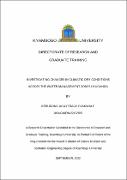Investigating changes in climatic dry conditions across the water management zones in Uganda
Abstract
Prolonged insufficient precipitation associated with evapotranspiration affects
society in various ways such as wilting of crops. Studies with comprehensive
analyses of climatic droughts while considering hydro-climatic differences among
the various Water Management Zones (WMZs) in Uganda are inadequate. This study
addressed this, by extracting extreme climatic indices (ECI) from precipitation and
potential evapotranspiration (PET), characterizing climatic drought across the WMZs
and analyzing connection of variability in the indices to large-scale oceanatmosphere
conditions from 1979 to 2013. Examples of the extracted ECIs included
number of dry days (NDD), number of consecutive dry days, and sum of PET, above
a defined threshold. The long term statistics of the extreme climatic conditions
showed Kyoga and Victoria as the driest and wettest WMZs in Uganda. The extent
and severity of drought were found to depend on the threshold for extracting the
ECIs. Furthermore, the severity of the drought was found to be disproportionate
across the country with the Kyoga and Victoria WMZs being the most and least
severely affected by the impacts of climatic drought. Generally, all WMZs exhibited
decreasing trends in the NDD over the study period, indicating that the country was
becoming wetter recently. Across the country, the Indian Ocean Dipole (IOD) was
negatively correlated with variability of a number of ECIs of both precipitation and
PET. However, correlation between Quasi Biennial Oscillation (QBO) and
variability of several ECIs was generally positive (p<0.05).
Key words: Drought, Climatic Indices, Evapotranspiration, Variability, Trend

